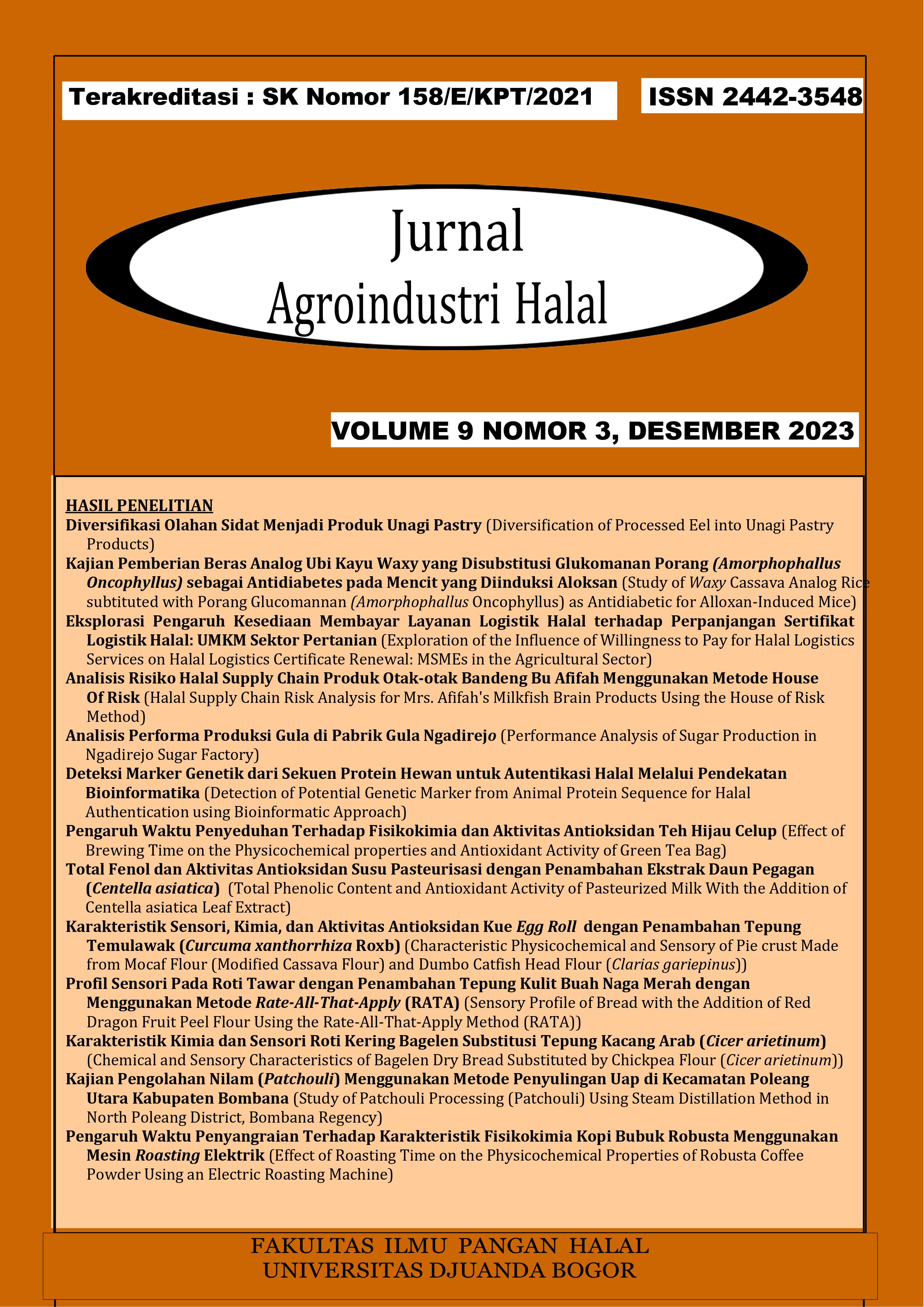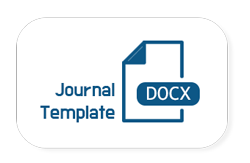Total Phenolic Content and Antioxidant Activity of Pasteurized Milk With the Addition of Centella asiatica Leaf Extract
DOI:
https://doi.org/10.30997/jah.v9i3.7433Keywords:
antioxidant activity, Centella asiatica leaf extract, DPPH, pasteurized milkAbstract
Milk has a high nutritional value. Minimal processing that can extend the shelf life of milk is pasteurization, but it can damage the nutritional content of milk. One of the additional efforts to improve milk quality and maintain the nutritional content of milk is to provide additional active compounds that act as antioxidants for milk consumers and the milk product itself. The use of Centella asiatica leaf extract as an ingredient is because there are at least 139 active compounds. This study aimed to study the total phenolic content and antioxidant activity of pasteurized milk with the addition of Centella asiatica leaf extract. The research was carried out in two stages, namely making gotu kola leaf extract and making pasteurized milk by adding gotu kola leaf extract concentrations of 0%, 0.25%, 0.5%, and 0.75%. Product analysis included total phenol analysis using Folin Ciocalteau and antioxidant activity using the DPPH method. Adding Centella asiatica leaf extract can increase total phenolic content and antioxidant activity. The total phenolic content obtained by adding Centella asiatica leaf extract at 0%, 0.25%, 0.50%, and 0.75% were 0.58 mgGAE/g, 1.93 mgGAE/g, respectively 2.33 mgGAE/g, and 3.41 mgGAE/g. At the same time, the results of antioxidant activity were 7.68%, 31.93%, 37.57, and 40.35%, respectively.
References
Agustiarini, V., Fauziyah, & Wijaya, P, D. (2020). Pengaruh Pemberian Variasi Gula Pasir pada Minuman Daun Pegagan (Centella asiatica (L.) Urban) Terhadap Organoleptik dan Kadar Β-Karoten. Jurnal Penelitian Sains 22(3) 2020,162-166.
Al-Farsi, M., Alasalvar, C., Al-Abid, M., Al-Shoaily, K., Al-Amry, M., & Al-Rawahy, F. (2007). Compositional and functional characteristics of dates, syrups, and their by-products. Food Chemistry, 104, 943-947.
Azmin, S. N. H. M., & Nor M. S. M. (2020). Chemical fingerprint of Centella Asiatica’s bioactive compounds in the ethanolic and aqueous extracts. Advances in Biomarker Sciences and Technology, 20. https://doi.org/10.1016/j.abst.2020.10.001
Cacho, N. T., & Lawrence, R. M. (2017). Innate Immunity and Breast Milk. Front. Immunol., 8:584.
Chaiwanichsiri, S., Dharmasuriya, N., Sonthornvit, N., & Janjarasskul, T. (2000). Process Improvement to Preserve the Color of Instant Pennywort Centella asiatica (Linn.) Urban Journal Scient Research Chulalongkorn University, 25(2), 237─ 243.
Chandrika, U, G., & Prasad, K. P. A. A. S. (2015). Gotu Kola (Centella asiatica): Nutritional Properties and Plausible Health Benefits. Advances in food and nutrition research. 1st ed., Vol 76
Departemen Kesehatan Republik Indonesia. (2005). Daftar Komposisi Bahan Makanan. Kementerian Kesehatan Republik Indonesia.
Dewi, G. R. (2022). Pengembangan Susu Pasteurisasi Menggunakan Variasi Kemasan Dan Penambahan Ekstrak Daun Zaitun (Olea Europae L.) Guna Memperpanjang Umur Simpan. [Skripsi, Universitas Gadjah Mada]. Repository UGM.
Fadillah, M., Syamsu, M.., & Kaulika, S. A. (2022). Uji Tingkat Keasaman dan Sifat Fisik Yoghurt dengan Penambahan Ekstrak Daun Pegagan (Centella asiatica) dan Bunga Rosella (Hibiscus sabdariffa). Risenologi, 7(1), 49–53. https://doi.org/10.47028/j.risenologi.2022.71.314
Handayani Y. (2010). Kajian Pembuatan Teh Celup Dengan Daun Pegagan (Centella Asiatica L. Urban). [Tesis, Institut Pertanian Bogor]. IPB University Scientific Repository.
Hardiana, R., Rudiyansyah., & Zaharah TA. (2012). Aktivitas Antioksidan Senyawa Golongan Fenol dari Beberapa Jenis Tumbuhan Famili Malvaceae. JKK, 1(1),8-13.
Hashim, P., Sidek, H., Helan, M. H. H.,Sabery, A., Palanisamy, U. M., & Ilham, M. 2011. Triterpene Composition and Bioactivities of Centella asiatica. Molecules, 16, 1310-1322.
Herlina, Malaka R, & Maruddin F. (2019). Aktivitas antioksidan dan karakteristik fisikokimia susu pasteurisasi dengan penambahan ekstrak daun binahong (Anredera cordifolia Tensteenis). Jurnal Agrisistem, 15(1).
Husna, A., & Holinesti, R. (2019). Analisis Kualitas Mie Basah Yang Dihasilkan Analisis Kualitas Mie Basah Yang Dihasilkan Dari Substitusi Ekstrak Daun Pegagan. Jurnal Kapita Selekta Geografi, 2 (8), 95-106
Joshi, K., & Chaturvedi, P. (2013). Therapeutic Efficiency of Centella asiatica (L.) Urban Underutilized Green Leafy Vegetable: An Overview.International Journal of Pharma and Bio Sciences, 4(1), 135─ 149
Kunjumon, R, Johnson, A. J, & Baby, S. (2022). Centella asiatica: Secondary metabolites, biological activities and biomass sources. Phytomedicine Plus, 2 (1). https://doi.org/10.1016/j.phyplu.2021.100176
Kumalaningsih, S. (2006). Antioksidan Alami Penangkal Radikal Bebas, Sumber manfaat , Cara penyediaan, dan Pengolahan. Trubus Agrisarana.
Kumar, T. S, Shanmugam, S., Palvannan, T., & Kumar, V. M. B. (2008). Evaluation of antioxidant properties of elaeocarpus ganitrus roxb. Leaves. Iranian J Pharmaceuti Res 7(3):211-215.
Lasmadiwati, E., Herminati, M. M., & Indriani,Y. H. (2003). Pegagan. Penebar Swadaya.
Lastriyanto, A., Kuncahyo, E, W., Komar, N. (2011). Desain dan Uji Prototype Alat Pasteurisasi Susu Berbasis Teknologi Irradiasi Ultraviolet (Kajian Dosis UV). Jurnal Rekayasa Mesin, 2(1), 7-16
Mardina, P. Pengaruh Kecepatan Putar Pengaduk dan Waktu Operasi pada Ekstraksi Tannin dari Mahkota Dewa. (2011). Jurnal Kimia, 5(2), 125-132
Nurhayati, T. D., Aryanti, & Nurjanah. (2009). Kajian Awal Potensi Ekstrak Spons Sebagai Antioksidan. Jurnal Kelautan Nasional, 2(2), 43-51
Pratiwi, N. I., Indrastuti, N. A., & Hapsari, D. R. (2022). Karakteristik Organoleptik Dan Fisikokimia Minuman Fungsional Ekstrak Kulit Buah Mangga Golek, Ekstrak Jahe Merah Dan Madu. [Skripsi, Universitas Djuanda Bogor].
Rahayu, N. K. T., Permana, D. G. M., &n Puspawati. G. A. K. D. (2020). Pengaruh Waktu Maserasi Terhadap Aktivitas Antioksidan Ekstrak Daun Pegagan (Centela asiatica (L.,) Urban). Jurnal Itepa, 9 (4), 482-489
Safitri YA, Rohajatien U, & Hidayati L. (2021). Pengaruh Penggunaan Konsentrasi Ekstrak Daun Pegagan (Centella Asiatica L. Urban) Terhadap Sifat Fisik dan Kapasitas Antioksidan Mochi Ice Cream. Jurnal Inovasi Teknologi dan Edukasi Teknik, 1(5). https://doi.org/10.17977/UM068v1n5p344-350
Saputri I & Damayanthi E. (2015). Penambahan Pegagan (Centella asiatica) Dengan Berbagai Konsentrasi Dan Pengaruhnya Terhadap Sifat Fisiko-Kimia Cookies Sagu. Jurnal Gizi Pangan, 10(2), 149-156
Sari DN & Azizah A. (2021). Pembuatan Minuman Instan Effervescent Daun Pegagan (Centella Asiatica (L.) Urban) Dengan Penambahan Effervescent Mix. Jurnal Pangan dan Agroindustri, 9(4). https://doi.org/10.21776/ub.jpa.2021.009.04.3
Sari, P. R. (2018). Karakteristik Organoleptik, Kandungan Gizi, Dan Aktivitas Antioksidan Velva Buah Naga (Hylocereus polyrhizus) dengan Penambahan Daun Pegagan (Centella asiatica L.). [Tesis, Institut Pertanian Bogor]. IPB University Scientific Repository
Sofia D. (2005). Antioksidan dan Radikal Bebas. Majalah Acid FMIPA, Universitas Lampung .
Tamimi W, Nurwantoro N , and Bintoro VP. (2019). Karakteristik Gelato Susu Kambing dengan Penambahan Ekstrak Daun Pegagan. Jurnal Teknologi Pangan, 3(1), 51–62. https://doi.org/10.14710/jtp.v3i1.22253
Tawiri, S, Gehlot S, & Gambhir, I. S. (2011). Centella asiatica: A Concise Drug Review with Probable Clinical Uses. Juornal of Stress Physiologt & Biochemistry, 7(201), 38─ 44
Winarno, F. G., & Fernandez, I. E. (2007). Susu dan Produk Fermentasinya. M-Brio Press.
Zainol, N. A., Voo, S. C., Sarmidi, M. R., & Aziz, R. A. (2008). Profiling of Centella asiatica (L.) Urban Extract. The Malaysian Journal of Analytical Sciences, 12(2):322-327
Downloads
Published
How to Cite
Issue
Section
License
Copyright (c) 2023 Distya Riski Hapsari, Intan Kusumaningrum, Arti Hastuti, Caesandra Indah Arlina, Lia Amelia

This work is licensed under a Creative Commons Attribution-ShareAlike 4.0 International License.
Authors who publish with Jurnal Agroindustri Halal agree to the following terms:
- Authors retain copyright and grant the journal right of first publication with the work simultaneously licensed under a Creative Commons Attribution 4.0 International License that allows others to share the work with an acknowledgement of the work's authorship and initial publication in Jurnal Agroindustri Halal.
- Authors are able to enter into separate, additional contractual arrangements for the non-exclusive distribution of the journal's published version of the work (e.g., post it to an institutional repository or publish it in a book), with an acknowledgement of its initial publication in Jurnal Agroindustri Halal.
- Authors are permitted and encouraged to post their work online (e.g., in institutional repositories or on their website) prior to and during the submission process, as it can lead to productive exchanges, as well as earlier and greater citation of published work









